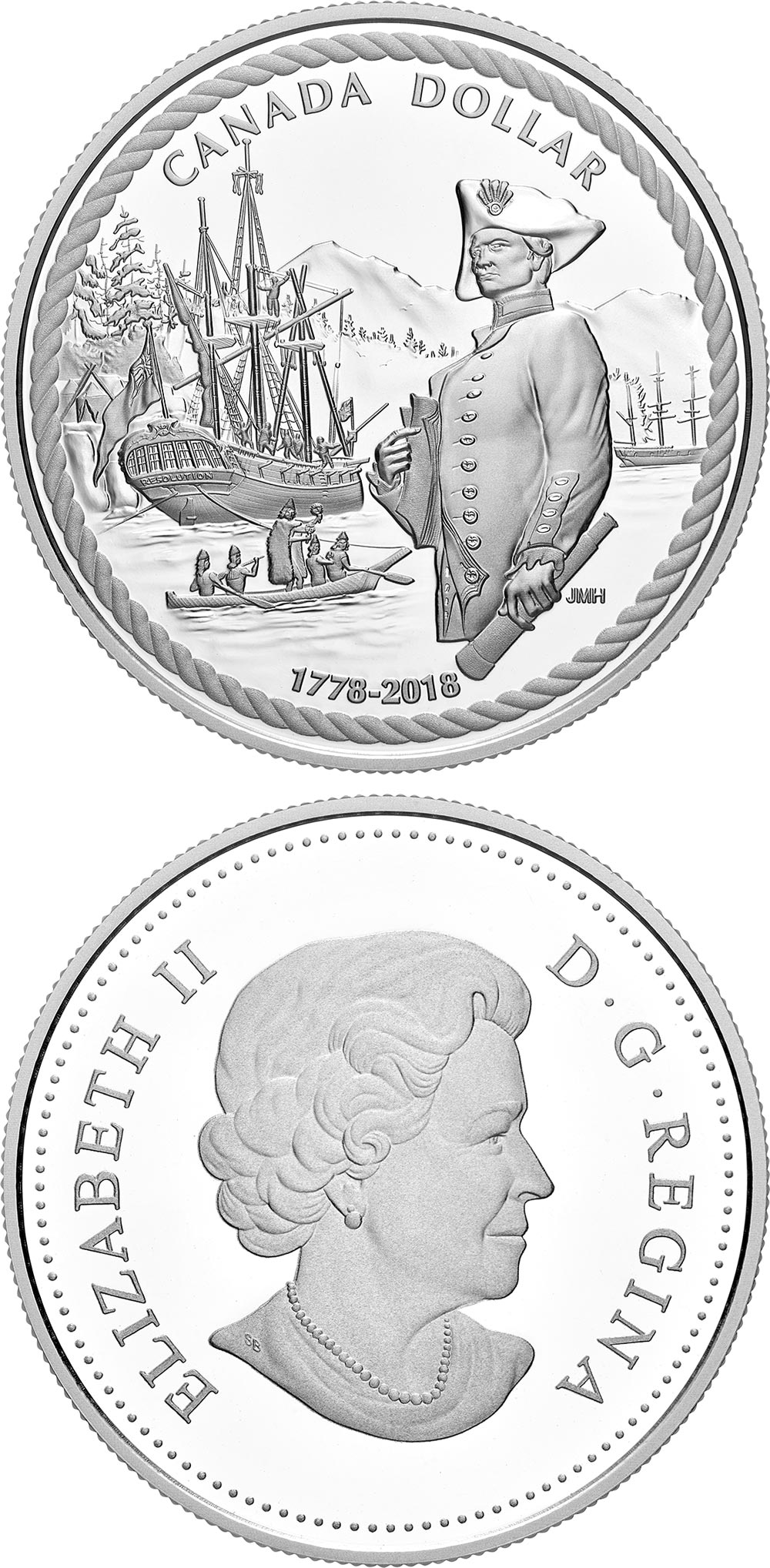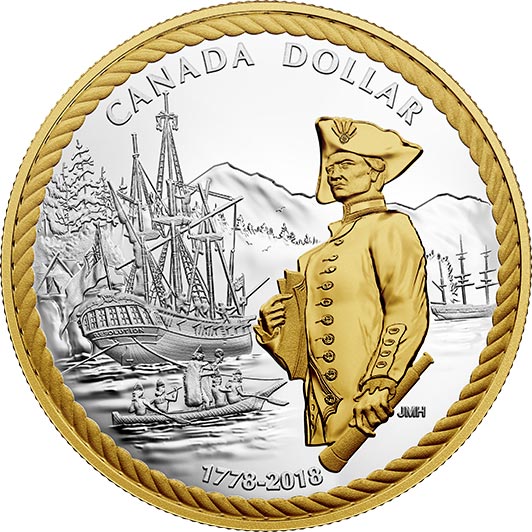1 dollar - 240th Anniversary of Captain Cook at Nootka Sound

Maritime artist John Horton presents an artistic rendering of Captain James Cook's arrival at Nootka Sound in April 1778. Towering mountains and the timbered headland of Bligh Island provide a stunning backdrop to this historical portrait, all precisely engraved in a superb proof finish and framed by a nautical twisted rope. Viewed in three-quarter profile, a stern-looking Cook keeps a watchful eye on his ship and crew while holding a telescope in one hand, his Admiralty orders in the other. Behind him is the HMS Discovery, which is moored a short distance away from HMS Resolution , whose crew is unrigging the ship and removing masts and spars in preparation for repairs. In the water, a group of Nuu-chah-nulth approach the Resolution in a canoe, ready to extend a friendly greeting. The obverse features the effigy of Her Majesty Queen Elizabeth II by Susanna Blunt.
History remembers Cook as the explorer whose voyages and exceptional surveying skills changed European perceptions of the Pacific region, by mapping many unknown shores throughout this vast expanse of ocean.
During his first two voyages—one from 1768 to 1771 and another from 1772 to 1775—Cook became the first European explorer to reach New Zealand and Australia's east coast, and the first to cross the Antarctic Circle. In 1776, a third voyage sent him on a quest to find the elusive Northwest Passage, which brought his two-ship expedition to Canada's Pacific coastline.
On April 1, 1778, HMS Resolution and HMS Discovery dropped anchor near Yuquot, on the western coast of Vancouver Island. Cook was cordially welcomed by Maquinna, chief of the Mowachat group of the Nuu-chah-nulth, leading the crew to refer to the area as Friendly Cove.
He was not the first European navigator to explore Canada's West Coast, but his was the first prolonged stay. During the month spent in Nootka Sound, the crew repaired the ships while Cook explored the area and engaged in local trade, exchanging metal goods for sea otter pelts that soon made the area a trade centre.
The expedition set sail once more on April 26, 1778, on a northerly course toward the Bering Sea. But Cook would not find the Northwest Passage; stopped by the Arctic's unyielding cold and ice, the expedition made a return trip to the Hawaiian islands discovered the year before, where Cook was killed in 1779. His legacy of exploration left an indelible imprint on the history of the Pacific region, and Canada too, where places like Cook's Harbour (N.L.) and Resolution Cove (B.C.) are lasting reminders of his passage through our coastal waters.
- Cook served as master of HMS Pembroke during the Seven Years' War, where he participated in the Siege of Louisbourg and the Battle of Quebec. But it was his skills as a cartographer that brought him to the attention of the Admiralty and the Royal Society—especially his detailed mapping of the Saint Lawrence River, which played a role in changing the course of Canadian history.
- Between 1762 and 1768, Cook explored Canada's eastern coastline. His survey of Newfoundland's coast resulted in the first large-scale, scientifically accurate charts of the coastal waters. Even in the 20th century, Cook's maps continued to serve as a useful reference tool for those sailing through these often-tricky waters.
- The name "Nootka Sound" may have arisen from a misunderstanding: It has been said that upon arriving, Cook mistakenly interpreted "itchme nutka" ("go around") as the name for the area he had originally named King George's Sound.
- International trade flourished at Nootka Sound after Cook's expedition. Published accounts of his voyage brought British and Spanish merchant ships to its shores, to trade for sea otter pelts. A decade later, competing claims over trade and navigation in the area pushed the two European nations to the brink of war.
- George Vancouver served as midshipman onboard Resolution during Cook's second voyage, and served on Discovery during the third voyage. He would return to Nootka Sound in 1792 while extensively charting the coast of British Columbia—including the island that bears his name. William Bligh, the master onboard Resolution, is another familiar name in maritime history—although he is perhaps more widely remembered for the mutiny that occurred onboard HMS Bounty during his command.
- Cook was known for running a tight ship; but having risen through the Navy ranks, he put great importance on the health of his crew. Daily bathing was required, and Cook also sought out fresh fruit at every stop to keep scurvy at bay.
Source: Royal Canadian Mint
